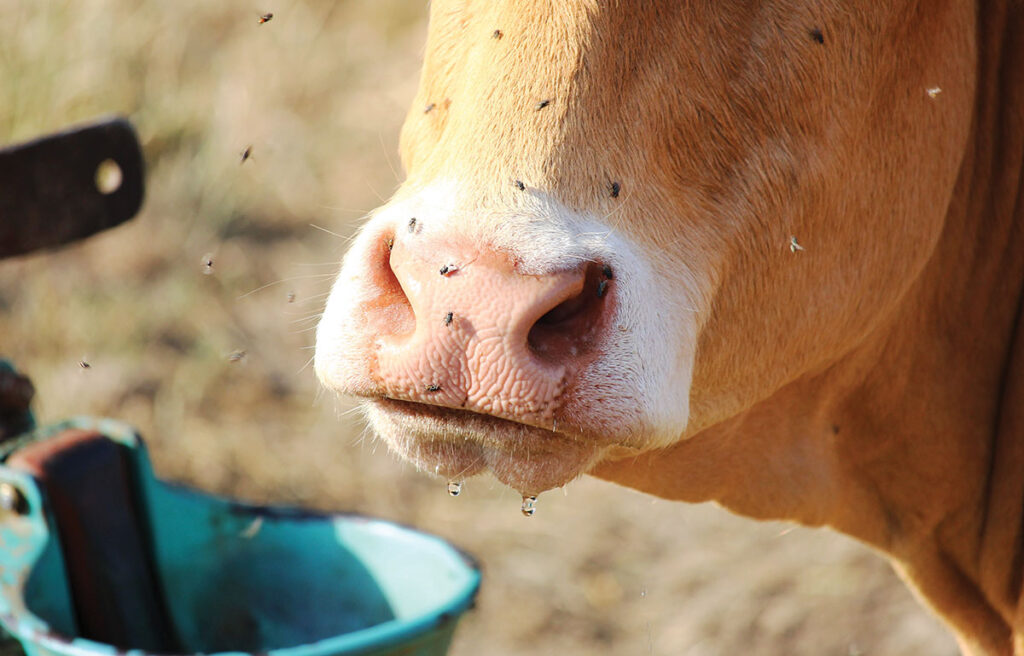
Tips to get ahead of insects before they infest herds
The beauty of spring is starting to arrive in the Ozarks along with the hope of many warm days on the horizon. Though there is much goodness that comes with warmer weather it also ushers in pests such as flies and ticks. According to extension entomologists, there are actions producers can take now to ward off large fly and tick infestations in the months to come.
Decrease Development Areas
One way to keep flies from proliferating this season is by eliminating environments where they grow the best. “Stable flies, Stomoxys calcitrans, develop in decaying organic matter and do quite well in manure mixed with wasted hay and urine,” Kelly Loftin, Ph.D., professor and extension entomologist with the University of Arkansas, said. “This excellent fly development media may buildup in winter feeding areas if sanitation was not considered from the onset.”
Round bales fed intact can leave behind piles of dirty, leftover hay. If this is the case, extension specialists recommend spreading out the mixture of hay and manure into a thin layer. Once the hay and organic matter dries, it will become a less suitable media for fly development.
Both stable flies and house flies develop in piles of hay wastage and organic matter. Extension entomologists recommend producers roll out hay bales during hay feeding season to minimize the possibility of wasted hay and organic matter buildup.
Monitor for Presence
Horn flies and face flies develop in a different way compared to stable flies and house flies. “Horn flies (Haematobia irritans) survive winter as pupae under manure pats and develop only in fresh cattle manure and face flies (Musca autumnalis) survive as adults and develop in fresh cattle manure, so cleaning up wasted hay has minimal effect on horn and face fly breeding,” Loftin explained.
Due to the nature of horn and face fly development, extension entomologists recommend producers monitor their animals for signs of horn flies and face flies. Knowing when the pests are present and how many there are, will be the determining factors in initiating pest control protocols. This is also the case for ticks.
When it comes to horn and face flies, Dr. Loftin recommends monitoring cattle with the goal of keeping the horn fly abundance below 200 flies per animal and face fly numbers below 10 per animal. Additionally, producers should evaluate pest populations throughout the season to determine if their fly control program is effective.
Vary Insecticide Class
Extension entomologists recommend recording the class of insecticide used to control horn flies and maintaining application records, especially when using insecticide impregnated ear tags. “To combat insecticide resistance in horn flies, switch insecticide classes from year to year,” Loftin advised. “It would be best if you could refrain from using a specific insecticide class for at least two years before returning to that class.”
Health Concerns
Flies and ticks can be the source of health concerns in cattle. Biting flies can serve as mechanical vectors of some cattle diseases, such as anaplasmosis. Horn flies are associated with increases in the prevalence of summer mastitis. Face flies are irritants and can mechanically transmit bacteria associated with pinkeye. Additionally, face flies can transmit the eyeworm, a parasitic nematode that infests the eye cavity.
Ticks can also be the culprits that spread some diseases to livestock. Along with the concerns posed by native tick species, a new species, the Asian longhorned tick, has been identified in the United States. The Asian longhorned tick is considered a threat to livestock. “Since its initial discovery in New Jersey in 2017, its confirmed range has expanded to 17 states including three counties in Missouri and two counties in Arkansas,” Loftin explained.
The Asian longhorned tick is unique because it can reproduce without mating. “This form of reproduction is called parthenogenesis where basically engorged, unmated female ticks can lay up to 2,500 eggs that eventually (after a couple of molts) become adult female ticks that can repeat this process,” Loftin stated. “As a result, enormous numbers can occur in the environment and on a host.”
The massive number of ticks that can attach to livestock can cause significant blood loss. The Asian longhorned tick can also infect cattle and other animals with a parasite that affects red and white blood cells resulting in anemia, weakness, jaundice and sometimes death.






